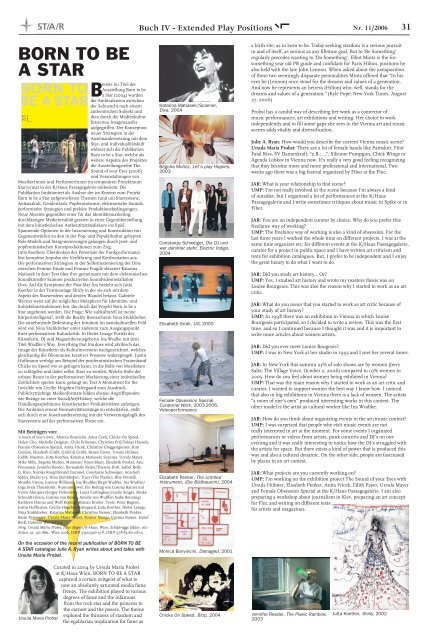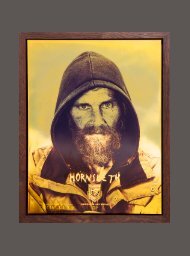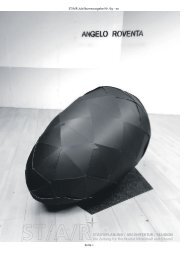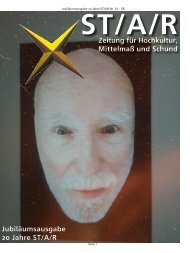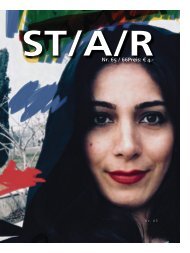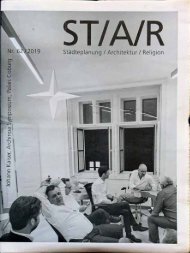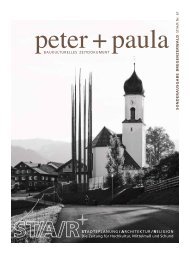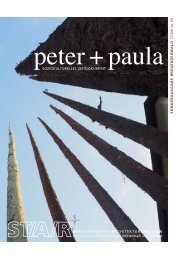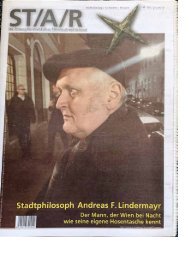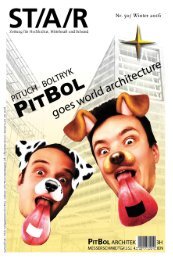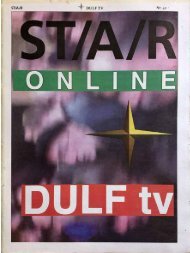ST:A:R_11
Erfolgreiche ePaper selbst erstellen
Machen Sie aus Ihren PDF Publikationen ein blätterbares Flipbook mit unserer einzigartigen Google optimierten e-Paper Software.
<strong>ST</strong>/A/R<br />
Buch IV - Extended Play Positions EP<br />
Nr. <strong>11</strong>/2006 31<br />
BORN TO BE<br />
A <strong>ST</strong>AR<br />
Bereits im Titel der<br />
Ausstellung Born to be<br />
a Star (2004) wurden<br />
die Ambivalenzen zwischen<br />
der Sehnsucht nach einem<br />
authentischen Subjekt und<br />
dem durch die Medienkultur<br />
forcierten Imagetransfer<br />
aufgegriffen. Der Konzeption<br />
neuer Strategien in der<br />
Auseinandersetzung mit dem<br />
Star- und Individualitätskult<br />
widmet sich die Publikation<br />
Born to be a Star, welche als<br />
weitere Aspekte des Projektes<br />
die Ausstellungsreihe The<br />
Sound of your Eyes (2006)<br />
und Veranstaltungen von<br />
MusikerInnen und PerformerInnen im temporären Projektraum<br />
Star/o/mat in der K/Haus Passagegalerie einbezieht. Die<br />
Publikation funktioniert als Analyse der im Kontext zum Projekt<br />
Born to be a Star aufgeworfenen Themen rund um Starsysteme,<br />
Antistarkult, Genderclash, Popfeminismus, elektronische Sounds,<br />
performative Strategien und prekäre Produktionsbedingungen.<br />
Neue Akzente gegenüber einer für das Identitätsmarketing<br />
durchlässigen Medienrealität geraten in einer Gegenüberstellung<br />
mit dem künstlerischen Authentitzitätsdiskurs ins Spiel.<br />
Spannende Optionen in der Inszenierung und Konstruktion von<br />
Gegenentwürfen zu den in der Pop- und Populärkultur gehypten<br />
Role-Models und Stargenerierungen gelangen durch post- und<br />
popfeministischen Kunstproduktionen zum Zug.<br />
Jutta Koethers Überdenken der Potentiale der Punkperformance<br />
löst komplexe Impulse der Verführung und Konfrontation aus.<br />
Die performativen Strategien in der Selbstinszenierung der Diva<br />
zwischen Femme Fatale und Femme Fragile skizziert Katarina<br />
Matiasek in dem Text über ihre gemeinsam mit dem elektronischen<br />
Soundkünstler Scanner produzierten Soundvideoinstallation<br />
Diva. Auf die Symptome der Post-Star Ära bezieht sich Jutta<br />
Koether in der Textmontage Shirly in der sie sich mit dem<br />
Aspekt des Starwerdens und dessen Wandel befasst. Gabriele<br />
Werner weist auf die möglichen Metaphern für Identitäts- und<br />
Subjektkonstruktionen hin, die durch das Projekt Born to be a<br />
Star angeboten werden. Die Frage: Wie subkulturell ist meine<br />
Körperintelligenz?, stellt die Reality Researcherin Nina Stuhldreher.<br />
Die zunehmende Bedeutung der Intuition im soziokulturellen Feld<br />
wird von Nina Stuhldreher unter anderem zum Ausgangspunkt<br />
ihrer performativen Kulturkritik. In Dieter Lesage Porträt der<br />
Künstlerin, DJ und Magazinherausgeberin Ina Wudke mit dem<br />
Titel Wudtke’s Way. Everything that Ina does wird akribisch das<br />
Image der Künstlerin als Kulturinvestorin nachgezeichnet, welches<br />
gleichzeitig die Ökonomien kreativer Prozesse widerspiegelt. Justin<br />
Hoffmann verfolgt am Beispiel der postfeministischen Frauenband<br />
Chicks on Speed wie es gelingen kann, in die Rolle von Musikstars<br />
zu schlüpfen und dabei selbst Stars zu werden. Welche Rolle der<br />
urbane Raum in der performativen Markierung einer individuellen<br />
Zeitlichkeit spielen kann, gelangt im Text A Monument for the<br />
Invisible von Cecilie Hogsbro Ostergaard zum Ausdruck.<br />
Publicityträchtige Medienformate bilden ebenso Angriffspunkte<br />
wie Bezüge zu einer Social(Art)History, welche die<br />
Handlungsspielräume künstlerischer Produktivitäten aufzeigen.<br />
Die Ambition erneut Normativitätszwänge zu entschärfen, stellt<br />
sich durch eine Auseinandersetzung mit der Verwertungslogik des<br />
Starsystems auf der performativen Ebene ein.<br />
Mit Beiträgen von:<br />
‘a room of one’s own’, Monica Bonvicini, Anna Ceeh, Chicks On Speed,<br />
Helen Cho, Michelle Deignan, Chilo Eribenne, Christina Ertl/Tobias Hassels,<br />
Female Obsession Spezial, Anita Fricek, Christine Gloggengiesser, Kim<br />
Gordon, Elisabeth Grübl, Grübl & Grübl, Renée Green, Ursula Hübner,<br />
Judith Huemer, Jutta Koether, Katarina Matiasek/ Scanner, Ursula Mayer,<br />
Mike Mills, Begoña Muñoz, Muntean/ Rosenblum, Elisabeth Penker, Anu<br />
Pennanen, Jennifer Reeder, Bernadette Reiter/Theresa Dirtl, Isabel Reiß,<br />
G. Rizo, Nicolas Roeg/Donald Cammel, Constanze Schweiger, Ann-Sofi<br />
Sidén, Studio 3+3, Nina Stuhldreher, Tracy+The Plastics, Rita Vitorelli,<br />
Monika Vision, Justene Williams, Ina Wudtke/Birgit Wudtke, Ina Wudtke/<br />
Inga Svala Thorsdottir. Nummer Zwei: Ein Beitrag von Cosima Rainer mit<br />
Victor Alimpiev/Sergey Vishnevsky, Laura Cottingham/Leslie Singer, Meike<br />
Schmidt-Gleim, Cosima von Bonin, Amelie von Wulffen Sadie Benning/<br />
Kathleen Hanna und Wolf Koenig/ Roman Kroitor. Texte: Peter Bogner,<br />
Justin Hoffmann, Cecilie Høgsbro Østergaard, Jutta Koether, Dieter Lesage,<br />
Nina Stuhldreher, Katarina Matiasek, Christina Nemec, Elisabeth Penker,<br />
Karin Pernegger, Ursula Maria Probst, Raimar Stange, Cosima Rainer, Isabel<br />
Reiß, Gabriele Werner u.a.<br />
Hrsg. Ursula Maria Probst, Peter Bogner/K-Haus, Wien. Schlebrügge Editor, 160<br />
Seiten, ca. 130 Abb., Wien 2006, ISBN 3-900926-15-8, ISBN 978-85160-081-0.<br />
On the occasion of the recent publication of BORN TO BE<br />
A <strong>ST</strong>AR catalogue Julie A. Ryan writes about and talks with<br />
Ursula Maria Probst.<br />
Katarina Matiasek/Scanner,<br />
Diva, 2004<br />
Begoña Muñoz, Let’s play Hippies,<br />
2003<br />
Constanze Schweiger, Die DJ und<br />
wer dahinter steht, Electric Indigo,<br />
2004<br />
Elisabeth Grübl, UG, 2000<br />
Female Obsession Spezial,<br />
Curatorial Work, 2003-2006,<br />
Videoperformance<br />
Elisabeth Penker, The Untitled<br />
Instrument, (Die Bildhauerin), 2004<br />
Monica Bonvincini, Damaged, 2001<br />
a birth-rite, as in born to be. Today seeking stardom is a serious pursuit<br />
in and of itself, as serious as any lifetime goal. But to ‘Be Something’<br />
regularly precedes wanting to ‘Do Something’. Elliot Mintz is the 60-<br />
something year old PR guide and confidant for Paris Hilton, positions he<br />
also held with the late John Lennon. When asked about the juxtaposition<br />
of these two seemingly disparate personalities Mintz offered that “In his<br />
eyes he (Lennon) once stood for the dreams and values of a generation.<br />
And now he represents an heiress (Hilton) who, well, stands for the<br />
dreams and values of a generation.” (Kyle Pope; New York Times, August<br />
27, 2006)<br />
Probst has a candid way of describing her work as a connector of<br />
music performances, art exhibitions and writing. Her choice to work<br />
independently and to fill some gaps she sees in the Vienna art and music<br />
scenes adds vitality and diversification.<br />
Julie A. Ryan: How would you describe the current Vienna music scene?<br />
Ursula Maria Probst: There are a lot of female bands like Pantskirt, First<br />
Fatal Kiss, SV Damenkraft, “z.B.: …”, Silicone Pumpgun, Chick Wings or<br />
Agenda Lobkov in Vienna now. It’s really a very good feeling recognizing<br />
that they become more and more professional and international. Two<br />
weeks ago there was a big festival organized by Fiber at the Fluc.<br />
JAR: What is your relationship to that scene?<br />
UMP: I’m not really involved in the scene because I’m always a kind<br />
of outsider, but I organized a lot of performances at the K/Haus<br />
Passagegalerie and I write sometimes critiques about music in Spike or in<br />
Fiber.<br />
JAR: You are an independent curator by choice. Why do you prefer this<br />
freelance way of working?<br />
UMP: The freelance way of working is also a kind of obsession. For the<br />
last three years I worked the whole time on different projects. I was at the<br />
same time organizer etc. for different events at the K/Haus Passagegalerie,<br />
curator for a project in public space and I have written art criticism and<br />
texts for exhibition catalogues. But, I prefer to be independent and I enjoy<br />
the great luxury to do what I want to do.<br />
JAR: Did you study art history… Or?<br />
UMP: Yes, I studied art history and wrote my masters thesis was on<br />
Louise Bourgeois. This was also the reason why I started to work as an art<br />
critic.<br />
JAR: What do you mean that you started to work as art critic because of<br />
your study of art history?<br />
UMP: In 1998 there was an exhibition in Vienna in which Louise<br />
Bourgeois participated, so I decided to write a review. This was the first<br />
time, and so I continued because I thought it was and it is important to<br />
write more articles about women artists.<br />
JAR: Did you ever meet Louise Bougeois?<br />
UMP: I was in New York at her studio in 1993 and I met her several times.<br />
JAR: In New York this autumn 23% of solo shows are by women (Jerry<br />
Saltz; The Village Voice, October 2, 2006) compared to 19% women in<br />
2005. How do you feel about women being exhibited in Vienna?<br />
UMP: That was the main reason why I started to work as an art critic and<br />
curator. I wanted to support women the best way I know how. I noticed<br />
that also in big exhibitions in Vienna there is a lack of women. The artists<br />
“a room of one’s own” produced interesting works in this context. The<br />
other model is the artist as cultural worker like Ina Wudtke.<br />
JAR: How do you think about organizing events in the art/music context?<br />
UMP: I was surprised that people who visit music events are not<br />
really interested in art at the moment. For some events I organized<br />
performances or videos from artists, punk concerts and DJ’s on one<br />
evening and it was really interesting to notice how the DJ’s struggled with<br />
the artists for space. But there exists a kind of power that is produced this<br />
way and also a cultural dynamic. On the other side, people are fascinated<br />
by places in an art context.<br />
JAR: What projects are you currently working on?<br />
UMP: I’m working on the exhibition project The Sound of your Eyes with<br />
Ursula Hübner, Elisabeth Penker, Anita Fricek, Edith Payer, Ursula Mayer<br />
and Female Obsession Spezial at the K/Haus Passagegalerie. I am also<br />
preparing a workshop about journalism in Kiev, preparing an art concept<br />
for Fluc and writing on different texts<br />
for artists and magazines.<br />
Curated in 2004 by Ursula Maria Probst<br />
at K/Haus Wien, BORN TO BE A <strong>ST</strong>AR<br />
captured a certain zeitgeist of what is<br />
now an absolutely saturated media fame<br />
frenzy. The exhibition played to various<br />
degrees of fame and the infamous<br />
from the rock star and the princess to<br />
the earnest and the posers. The theme<br />
explored the thinness of stardom and<br />
Ursula Maria Probst<br />
the egalitarian implication for fame as<br />
Chicks On Speed, Blop, 2004<br />
Jennifer Reeder, The Plasic Rainbow,<br />
2003<br />
Jutta Koether, Shirly, 2002


